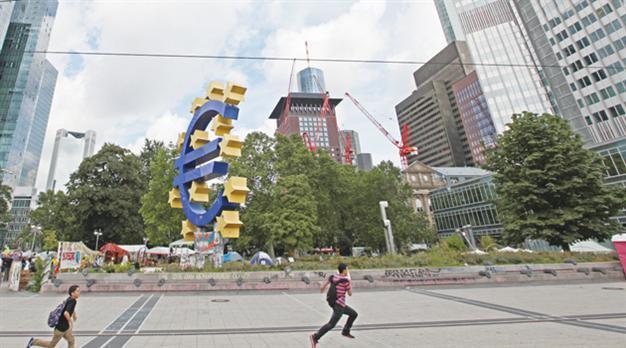Europe on the edge of recession
LONDON - The Associated Press

A logo of the euro currency stands in front of the European Central Bank (R) in Frankfurt. The eurozone economy shrank by 0.2 percent in the second quarter.
Europe is edging closer to recession, dragged down by the crippling debt problems of the 17-country euro bloc, official figures showed yesterday.Eurostat, the European Union’s statistics agency, revealed that the economies of both the eurozone and the wider 27-country EU shrank by a quarterly rate of 0.2 percent in the second quarter of the year. In the first quarter, output for both regions was flat. A recession is officially defined as two straight quarters of falling output.
Europe’s stumbling economy is making it harder for other economies around the world to recover and policymakers from all round the world are urging more decisive action, particularly from the European Central Bank, to deal with the crippling debt crisis to restore confidence to the global economy. “The ECB’s recent announcement that it will do ’whatever it takes’ to save the euro is welcome, but clarity over what will be done is crucial,” said Tom Rogers, a senior economic adviser for accounting firm Ernst & Young.
Germany grows 0.3 percent
The region is the U.S.’s largest export customer and any fall-off in demand will hit order books - as well as U.S. President Barack Obama’s election prospects.
The eurozone is grappling with sky-high debt levels and record unemployment of 11.2 percent. Compared with the year before, the eurozone’s economy is 0.4 percent smaller. Without Germany continuing to post solid levels of growth, the eurozone would officially be in recession.
Europe’s largest economy grew by a quarterly rate of 0.3 percent in the second quarter. Though down on the 0.5 percent recorded in the first quarter, the advance was a little more than expected - most economists thought Germany would only grow by 0.2 percent.
Though Germany currently benefits from strong demand for its products, its high-value exporters are finding it increasingly difficult to tap international markets. Forward-looking surveys, including closely-monitored ZEW survey of German investor sentiment, are suggesting that confidence is taking a knock as Europe moves from one crisis point to another. The other 16 countries that use the euro are Germany’s biggest export market and six of them are in recession. The U.S. is also coming off the boil, with growth in the second quarter down compared to the previous three months at 0.4 percent, according to Eurostat.
Slower economic growth is also making it harder for governments and central banks to control the debt crisis in Europe. Shrinking economies make it more difficult to get the public finances into shape. Lower output dents tax revenues while forcing up the cost of social benefits.
“The big picture is that the economic growth required to bring the region’s debt crisis to an end is still nowhere in sight,” said Jonathan Loynes, chief European economist at Capital Economics.
For those countries at the front-line of Europe’s debt crisis, the figures make for grim reading. Unsurprisingly, Greece is faring the worst - its economy is 6.2 percent smaller than a year ago and back at the level it was in 2005.
Portugal, which has also been bailed out and enacting the tough austerity medicine, suffered a big 1.2 percent drop in output in the second quarter, compared with the previous quarter’s modest 0.1 percent drop.
Italy and Spain, the eurozone’s third and fourth largest economies, shrank by 0.7 percent and 0.4 percent respectively in the second quarter. Both countries are struggling to convince markets they have a strategy to get a grip on their debts. Spain has even acceded to a bailout of its banks.
















